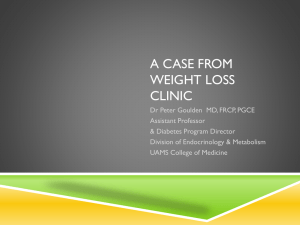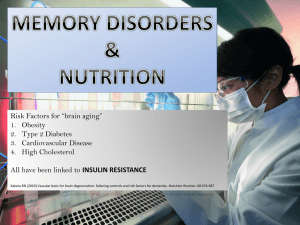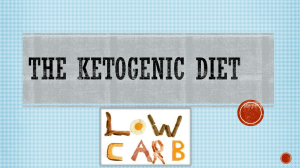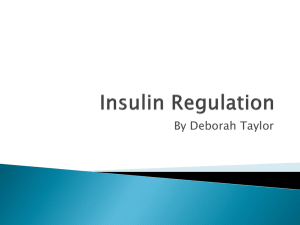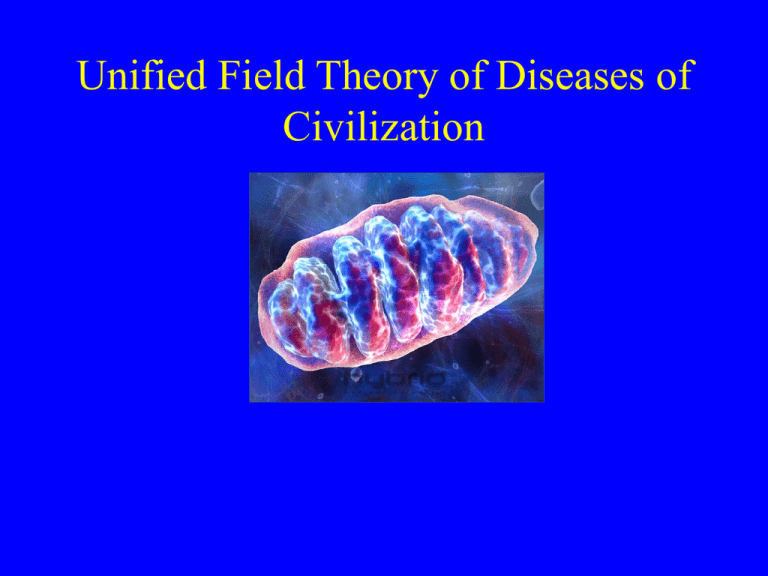
Unified Field Theory of Diseases of
Civilization
Credentials
Private Practice, Family Medicine and Bariatric Medicine in Northeast Kansas
Medical Director, University of Kansas Weight Control Program (VLCD-very low
calorie liquid diet)
Consultant, Duke Diet and Fitness Center
Consultant, Atkins Nutritionals, Inc.
Consultant, Veronica Atkins
Clinical Faculty, University of Kansas Medical School
Diplomate of the American Society of Bariatric Physicians
Past President, American Society of Bariatric Physicians
Fellow, American Society of Bariatric Physician
Co-author, lay press diet book
Co-author, “Dietary Treatment of the Obese Individual” and “Medical Treatment
of Pediatric Obesity” in Handbook of Obesity Treatment.
Partner: Innovative Metabolic Solutions
Credentials
Behavioral
40 + years training animals including cats, dogs, horses, and
one chicken.
I have participated in the training of 10 nationally ranked
agility dogs including the #2 beagle (2 years) and #1
Norfolk Terrier (8 years)
Currently employed by Joan Meyer (Triune Training) AKC
World Agility Team member 2001, 2003, 2008.
I specialize in behavior problems as well as the biomechanics
of the working animal.
Metabolic Health
Its not the weight, it’s the fuel source.
Metabolic Syndrome
•
•
•
•
Vernon, M.
Retrospective chart review
Outpatient clinical setting
124 patients-64 rx’d low CHO
57 rx’d low fat + anorectic
Vernon, M. C., B. Kueser, et al. (2004). "Clinical Experience of a Carbohydrate-Restricted Diet for
the Metabolic Syndrome." Metabolic Syndrome and Related Disorders 2(3): 180-186.
Methods
Outpatient clinical setting
Low fat diet + phen/fen (n=64)
Carbohydrate restricted diet (n=57)
Diet prescription was written.
20 grams carbohydrate/day until weight loss goal
obtained or patient willing to slow weight loss.
Both groups routinely monitored with office
visits and blood work.
Parameters Followed
Vital Signs; Blood Pressure, TPR, Weight.
Initially used caliper measurements of Body Fat
(Phen-fen). Low CHO patients followed with bioelectric impedance body composition scale.
Obtained CBC, fasting lipids, thyroid studies,
chemistry panel, C-peptide and UA.
Now also obtain hs-CRP, 24 hr urine for creatinine
clearance and microalbumin followed on all
diabetic patients. Labs repeated at ~3 mon.
intervals until stable weight –then at least yearly.
Demographics
LF Diet + Meds
Carb Restriction
mean (SD)
mean (SD)
n
56
66
Age, years
41.3 (8.7)
Gender female
80.4%
71.2%
Race Caucasian
94.6%
92.3%
Height, inches
66.2 (3.5)
65.9 (3.7)
Weight, kg
94.0 (21.1)
97.7 (28.8)
Body mass index, kg/m2
38.3 (7.4)
38.7 (11.1)
Family history of obesity
82.1%
65.2%
Hypertension therapy
21.4%
33.3%
Diabetes mellitus therapy
8.9%
22.7%
Lipid therapy
16.2%
27.6%
Psychiatric medical therapy
21.4%
21.2%
Thyroid therapy
19.6%
6.1%
47.9 (12.7)
Results
Low-Fat Diet + Medication
Variable
Baseline Follow-up Change
Carbohydrate Restricted Diet
Baseline Follow-up Change P value*
Mean
Body weight, kilograms** 108.7
94.9
-12.7% 108.2
98.7
-8.8%
0.005*
Total cholesterol, mg/dl
219.9
194.8
-11.4% 213.9
203.1
-5.0%
0.39
Triglycerides, mg/dl
210.5
151.8
-27.9% 203.8
115.5
-43.3% 0.02*
LDL-C, mg/dl
134.9
121.2
-10.2% 123.0
128.0
+4.1%
0.52
HDL-C, mg/dl
40.2
40.8
+1.5%
48.9
+9.4%
0.003*
Total chol/HDL-C ratio
5.8
5.1
-12.1% 5.3
4.6
-13.2% 0.08
Trigycerides/HDL-C ratio
5.8
4.3
-25.9% 5.7
2.8
-50.9% 0.01*
44.7
** The mean follow-up was 20.2 wks for the LF Diet + Meds group and 15.0 wks for the Carb
Restriction group
How did these options compare?
• Weight loss almost as much with CHO
restriction as our best medication effort
using phen/fen.
• Lipid profile was markedly improved:
• 51% improvement in Trig/HDL ratio (an
emerging marker of cardiovascular
disease).1
Gaziano JM, Hennekens CH, O’Donnell CJ, Breslow JL, and Buring JE “Fasting Triglycerides, highdensity lipoproteins and risk of myocardial infarction.” Circulation 96: 2520-2525 (1996)
1
Rate of Loss
250
Body Weight, lbs (sem)
240
230
Very Low Carbohydrate Diet
220
210
200
190
Phen/Fen and Low Calorie Diet
180
170
Wk 0
Wk 4
Wk 8
Wk 12
Wk 16
Wk 20
Duration of Intervention
* p = 0.04 comparing change from Week 0 to Week 24 between groups
Wk 24
News Flash
Not all weight loss is the same in terms of
metabolic state.
Metabolic outcomes are different based on the
fuel source ( fat or carbohydrates)
What Can You Impact?
• Any condition related to hyperinsulinemia:
• CAD, prediabetes, metabolic syndrome, Type 2 diabetes
mellitus, hypertension, hyperlipidemia, dyslipidemia
including high triglycerides and low HDL, proteinuria due
to metabolic syndrome, obesity, acanthosis nigricans
• Central nervous system irritability such as seizures and
migraines
• Ovarian dysfunction due to hyperinsulinemia manifested
as polycystic ovary syndrome, irregular menses,
anovulation, irregular ovulation, facial hirsuitism
• GERD
• Sleep apnea, Pickwician syndrome
• Gestational diabetes, pre-eclampsia
• Osteoarthritis
• Inflammation
• Some Psychiatric conditions
Diseases of Civilization
Elevated carbohydrate intake (different
tolerance from one individual to another)
causes chronically high levels of insulin and
other inflammatory mediators.
These are the drivers of the diseases of
civilization-hypertension, metabolic
syndrome, prediabetes, diabetes and excess
fat mass gain.
Mitochondrial Energy Production
This is the key to life.
No mitochondrial energy production=death
No mechanic, no oil changes, only on-site
repair and oxidation must continue at all
times.
That’s a challenge-and nutrition is the key.
Mitochondrial Fuel Source
Mitochondrial fuel source is linked to
oxidative stress
Oxidative stress is linked to tissue damage
Mitochondrial enzymes adjust to fuel source
Constant mitochondrial energy production
without oxidative damage is the goal.
Is Adiposity the problem?
Sunburn is the best analogy
Genetic predisposition and environmental
exposure combine to cause damage.
Adiposity is a marker for hyperinsulinemia.
Excess adipose tissue is part of the pathologic
process of insulin resistance and
hyperinsulinemia
Two Approaches to Understanding
Human Metabolism
Classic
•
All calories have equal value,
regardless of source
• Importance of each
macronutrient tied to caloric
density
• Weight gain when energy intake
exceeds energy expenditure
• Lose weight by reducing caloric
intake and/or increasing caloric
expenditure
Hormonal
•
Increased carbohydrate intake
increases insulin production and
decreases lypolysis (fat-burning)
• Macronutrients control metabolic
hormone production, which
controls storage metabolism.
• High carbohydrate consumption
leads to hyperinsulinemia, which
leads to obesity and Metabolic
Syndrome
Hormones
Insulin
Glucagon
Incretins
Epinephrine
Norepinephrine
Cortisol
Sex Steroids
Branched chain amino acids
IL-6
Dietary Carbohydrates
Visceral Adiposity
Dr. Eric Freedland proposed the concept of the “critical
visceral adipose threshold”-the amount of visceral fat storage that
an individual could gain after which metabolic obesity ensued.
This hypothesis, in conjunction with individual tissue levels of
insulin resistance, may explain why one person is obese to the eye
but has fewer metabolic abnormalities while an apparently thin
individual is metabolically at risk.
Freedland, E. S. (2004). "Role of a critical visceral adipose tissue threshold
(CVATT) in metabolic syndrome: implications for controlling dietary
carbohydrates: a review." Nutr Metab (Lond) 1(1): 12.
Physiology of Obesity Treatment
Obesity is excessive adipose tissue (fat)
“Excess” is defined by metabolic and functional
parameters
The goal is to mobilize, or “burn fat”
To accomplish this goal, a change from “glucose
burning” to “fat burning” is needed
Fat Metabolism and Insulin
The hormonal milieu needs to be appropriate for “fat
burning”
The effect of insulin to facilitate glucose uptake is
linked to fat synthesis
“Fat burning” is inhibited by insulin, so insulin levels
need to be around basal levels
Insulin levels can be lowered by:
Increasing energy expenditure
Reducing carbohydrate intake
Insulin Promotes Fat Synthesis
Glucagon Promotes Fat Burning
Fatty acid
synthase
citrate
TCA cycle
mitochondria
Triglycerides
Malonyl CoA
ACCb
Glucose abundant-TCA
producing citrate via
acetyl CoA and
oxaloacetate. Insulin
increases availability of
TCA intermediates via
enzyme regulation
cytosol
CPT I
Acetyl CoA carboxylase
(ACCb ) is activated by
citrate and insulin, inhibited
by glucagon.
Fatty acid synthase inhibited
by glucagon
Intracellular and
intravascular
CPT I (Carnitine
palmitoyltransferase I)
moves long chain fatty acyl
CoA groups into the
mitochondria for oxidation.
Inhibited by malonyl CoA.
Fuel Sources: Fatty acids, ketones, glucose
Fatty acids can be utilized by most tissues for energy.
Ketone bodies are generated by the liver from fatty acid
oxidation. Ketones can be utilized by all cells except
glucose obligate cells and liver.
Glucose is synthesized by the liver and renal medulla from
amino acid precursors (gluconeogenesis). Cells without
mitochondria (erythrocytes, cornea, lens, retina) and cells
in low oxygen tension conditions (renal medulla) are
obligate glucose users.
Fatty Acids
Fatty acids are the main cellular fuel for all non-obligate
glucose using cells
Preferred fuel of the myocyte
A large pool of fatty acids are circulating on albumin at
any given time
There is nearly unlimited storage potential as
triglyceride in adipose tissue
Ketone bodies
Ketone bodies are molecules that deliver energy
(acetoacetate, acetone, b-hydroxybutyrate)
Ketone levels
Fed state
Overnight fast
0.1 mmol/L
0.3 mmol/L
Nutritional ketosis
1 - 2 mmol/L
> 20 days fasting
10 mmol/L
Diabetic ketoacidosis
> 25 mmol/L
Meckling et al. Can J Physiol Pharmacol 2002;80:1095-1105.
Sharman et al. J Nutr 2002;132:1879-1885.
Yancy et al. Eur J Clin Nutr 2007;February 17:1-7.
Glucose
Can come from diet, but also from internal sources
Excess is stored as glycogen in limited amounts, or as
triglyceride
Protein (amino acids) used by liver and kidney to produce
glucose (gluconeogenesis) and glycogen (glycogenesis)
Under mixed diet conditions, CNS use of glucose can be as high
as 120 grams/day
However, daily glucose use is only about 30 grams/day when
adapted to fat burning state (when fatty acids and ketones are
available for muscle and CNS use)
This 30 grams of glucose is easily supplied by endogenous
sources
Caloric Content of Food
A Calorie (kcal) is the amount of heat required to raise the temperature
of 1 kg of water by 1 degree Celsius
Foods can be oxidized to release energy, and the estimated caloric
values using bomb calorimetry are:
Triglyceride: 9.461 kcal per gm…… 9 kcal
Protein: 4.442 kcal per gm………… 4 kcal
Carbohydrate: 4.183 kcal per gm... 4 kcal
Alcohol: 7 kcal per gram……………7 kcal
Ketones: 4.5 cal per gram………….4 kcal
The actual caloric value will depend upon what oxidation pathway is
used, whether the energy has been stored, etc.
Glycogen is stored with water 1:3, so 1 gram of glycogen leads to 4
Oh, Those Free Radicals
• The effect of burning glucose as fast as
•
•
possible overwhelms the mitochondrial
electron transport chain and generates
increased numbers of free radicals.
Free radicals cause tissue damage.
Control glucose/insulin metabolism=control
free radical formation=control tissue
destruction.
Salway JG, Metabolism at a Glance. Third edition. Blackwell Publishing Ltd, 2004.
Veech, R. L., B. Chance, et al. (2001). "Ketone bodies, potential therapeutic uses."
IUBMB Life 51(4): 241-7.
Free Radical Management Plan
“Finally there are broad therapeutic implications from
the ability of ketone body metabolism to oxidize the
mitochondrial co-enzyme Q couple. The major source
of mitochondrial free radical generation is Q
semiquinone. The semiquinone of Q, the half-reduced
form, spontaneously reacts with O2 to form free
radicals. Oxidation of the Q couple reduces the
amount of the semiquinone form and thus would be
expected to decrease O2- production.” 1
Veech RL. The therapeutic implications of ketone bodies: the effects of ketone bodies in pathological
conditions: ketosis, ketogenic diet, redox states, insulin resistance, and mitochondrial metabolism.
Prostaglandins Leukotrienes Essential Fatty Acids 2004;70:309-19.
Mitochondrial Ketone Metabolism
Vacuums Free Radicals
In addition, the metabolism of ketones causes a reduction of the
cytosolic free {NAD+}/{NADH} couple which is in near
equilibrium with the glutathione couple. Reduced glutathione
is the final reductant responsible for the destruction of H2O2.
Veech RL. The therapeutic implications of ketone bodies: the effects of ketone bodies
in pathological conditions: ketosis, ketogenic diet, redox states, insulin resistance,
and mitochondrial metabolism. Prostaglandins Leukotrienes Essential Fatty Acids
2004;70:309-19.
Ketones Improve Myocardial
Function
“How ketone bodies could improve the hydraulic
efficiency of heart by 28% could not be explained
by the changes in the glycolytic pathway alone,
but rather by the changes that were induced in
mitochondrial ATP production by ketone body
metabolism.”
Veech RL. The therapeutic implications of ketone bodies: the effects of
ketone bodies in pathological conditions: ketosis, ketogenic diet, redox
states, insulin resistance, and mitochondrial metabolism.
Prostaglandins Leukotrienes Essential Fatty Acids 2004;70:309-19.
Ketotic Benefits
Chronic adaptation to fat as primary energy
source may offer benefits such as improved
cerebral function (treatment of seizures),
improved mitochondrial ATP production,
decreased oxidative stress and protection of
glycogen stores during exercise.
Kossoff, E. H. (2004). "More fat and fewer seizures: dietary therapies for epilepsy."
Lancet Neurol 3(7): 415-20.
Phinney, S. D., B. R. Bistrian, et al. (1983). "The human metabolic response to
chronic ketosis without caloric restriction: preservation of submaximal exercise
capability with reduced carbohydrate oxidation." Metabolism 32(8): 769-76.
Dietary CHO =Insulin Secretagogue
Boden, G., K. Sargrad, et al. (2005). "Effect of a low-carbohydrate diet on appetite, blood glucose levels, and insulin
resistance in obese patients with type 2 diabetes." Ann Intern Med 142(6): 403-11.
Carbohydrate Signal Effects on
Metabolic Hormones
Ludwig, D. S., J. A. Majzoub, et al. (1999). "High glycemic index foods, overeating, and obesity." Pediatrics 103(3): E26.
Eat or Die
Ludwig, D. S., J. A. Majzoub, et al. (1999). "High glycemic index foods, overeating, and obesity." Pediatrics 103(3): E26.
Lack of Postprandial Rise in Serum Glucose
and Insulin After a Low Carbohydrate Meal
Glucose and insulin concentrations in response to a 300 kcal meal with low(closed circles), intermediate- (open circles), and high-carbohydrate
(triangles) content after 10 d on these respective diets (n=6).
Data are means (SE). Areas under the curve for insulin was different for each
diet (P 0.001). Glucose area under the curve was lower in response to the
low-carbohydrate diet (P 0.001 vs. other diets).
Bisschop et al. J Clin Endocrinol Metab;2003:88:3801–3805.
Eating Fat Equals Fasting
The importance of either carbohydrate or energy restriction in initiating the
metabolic response to fasting was studied in five normal volunteers. The
subjects participated in two study protocols in a randomized crossover fashion.
In one study the subjects fasted for 84 h (control study), and in the other a
lipid emulsion was infused daily to meet resting energy requirements during
the 84-h oral fast (lipid study). Glycerol and palmitic acid rates of appearance
in plasma were determined by infusing [2H5]glycerol and [1-13C]palmitic
acid, respectively, after 12 and 84 h of oral fasting. Changes in plasma glucose,
free fatty acids, ketone bodies, insulin, and epinephrine concentrations during
fasting were the same in both the control and lipid studies. Glycerol and
palmitic acid rates of appearance increased by 1.63 +/- 0.42 and 1.41 +/- 0.46
mumol.kg-1.min-1, respectively, during fasting in the control study and by
1.35 +/- 0.41 and 1.43 +/- 0.44 mumol.kg-1.min-1, respectively, in the lipid
study. These results demonstrate that restriction of dietary carbohydrate, not
the general absence of energy intake itself, is responsible for initiating the
metabolic response to short-term fasting.
Klein, S. and R. R. Wolfe (1992). "Carbohydrate restriction regulates the adaptive
response to fasting." Am J Physiol 262(5 Pt 1): E631-6.
The New Paradigm
Food can exert hormonal type influence on
metabolic pathways
Fat is not the problem
The changes caused by excess dietary
carbohydrate intake result in a shift in
metabolic pathways (characterized by
elevated insulin levels) which increase
inflammation and tissue damage.
Hyperinsulinemia and Reactive
Hypoglycemia
Time
Glucose Insulin
(mg/dl)
(uIU)
fasting
115
19
1 hr
261
72
2 hr
212
119
3 hr
41
34
50 yo red headed female
Weight=191.3 lbs
Hgt=63 inches
BMI=33.9
DM with elevated Insulin
54 yo wf . 269 lb. 5’6” tall. BMI=43.4
Multiple complaints: gluten enteropathy,
vegetarian, joint aches
Meds: Synthroid 62.5 mcg/day, Accupril 40
mg po daily, HCTZ 25 mg po daily
Referred by Dr. Phinney, Dr. Westman, and
Dr. Kolotkin
Type 2 DM with elevated insulin levels
Time
Glucose
Insulin
(mg/dl)
(uIU)
fasting
123
81
1 hr
273
632
2 hr
200
777
3 hr
119
259
54 yo Caucasian female
Weight=269 lbs
Hgt=66 inches
BMI=43.4
Stage 5 (DM) with
reactive hypoglycemia
and hyperinsulinemia.
Type 2 DM with Elevated Insulin levels
Treatment Outcomes
Test
Wgt
Gluc
% change
(lbs)
Weight (lbs)
269
245
-9
Glucose (mg/dl)
123
99
-20
HgbA1C (%)
6.0 (<5.7)
5.1
-15
Cpeptide
8.9 (<4.5)
4.3
-52
T. Chol (mg/dl)
157(<200)
146
-7
Triglyceride(mg/dl)
222 (<150)
72
-68
HDL (mg/dl)
36 (>50)
37
+2
LDL (mg/dl)
76.6 (<100)
95
+24
T.chol/HDL
4.36
3.95
-9
Trig/HDL
6.16
1.9
-69
Type 2 DM 3 hr GTT with Insulin Levels
Time
Glucose Insulin
(mg/dl)
(uIU)
fasting
131
14.9
1 hr
278
50.9
2 hr
246
40.3
3 hr
158
27
56 yo Caucasian female
Weight=276 lbs
Hgt= 62 inches
BMI= 50.1
Stage 5 moving to Stage 6
Insulin levels don’t adequately
suppress serum glucose response
to dietary carbohydrate. Insulin
resistance present.
Reactive hypoglycemia present
Type 2 DM with Low Insulin levels
Treatment Outcomes
Test
Baseline
3 months
% change
Weight (lbs)
276
226
-18
Glucose (mg/dl)
109
90
-17
HgbA1C (%)
7.1 (<5.7)
5.4
-24
T. Chol (mg/dl)
249 (<200)
226
-9
Triglyceride(mg/dl)
125 (<150)
99
-21
HDL (mg/dl)
64 (>50)
54
-15
LDL (mg/dl)
160 (<100)
152
+5
T.chol/HDL
3.89
4.1
+5
Trig/HDL
1.95
1.83
-6
Remission of Type II Diabetes
A 45 year old white female with Type II diabetes mellitus, obesity (BMI =
60.5), HTN on pioglitizone, glipizide, and metformin, lisinopril, sertraline, oral
contraceptives, itraconazole, rofecoxib.
Date
Wt (lbs) Chol
7/00
375
7/00
Initiation of Carbohydrate Restricted Diet
9/00
350
153
193 69
45
7.7
3
1/01
317
165
153 84
50
6.4
1.8
12/01
243
198
131 116
56
5.4
2
257
Trig LDL
252 118
HDL
50
HgbA1C Trig/HDL
11.0
5
BMI
60.5
39.2
All hypoglycemic meds dc’d 7/00. Off all meds except setraline by 9/01
Not Just For Weight
Individuals with normal BMI may exhibit
the metabolic characteristics of obesity.
This is not treatment of adiposity- it is
metabolic management of metabolic risk
through dietary treatment/lifestyle change.
This works whether or not excess fat mass
is present.
Metabolic Fitness
Improvement in Metabolic Fitness Without Weight
Change
A 48 year old WF requested dietary treatment for abnormal lipids.
Date
Chol
Trig
HDL T/HDL Weight (lbs) % B F HgbA1c
9/99
256
2208
20
3/01
214
2407
----
3/01
Initiation of Carbohydrate Restricted Diet
11/01
162
147
31
4.7
7/02
145
127
37
8/03
149
84
39
110
158
158
36
5.8
157
29
6.0
3.4
153.5
31
---
3.8
147
27.5
5.1
What about other lipid problems?
Decrease in Lp(a) Without Weight Loss
A 28 year old white female with strong FH of premature CAD. Acne
rosacea and hypertrophic skin over elbows. (BMI=17.5)
Date
Lp(a)
3/97
Chol
Trig
LDL
HDL
Wt (lbs)
215
87
171
27
98
3/00
64
214
113
154
37
109
2/01
52
243
95
197
27
112
7/01
Initiation of Carbohydrate Restricted Diet 104
11/01
44
211
66
153
45
101
2/02
36
176
52
113
52
110
(normal Lp(a) < 32)
Current Testing Misses the Problem
Insulin resistance, hyperglycemia, hyperinsulinemia, hyperlipidemia
and oxidative stress are risk factors related to cardiovascular diseases
including congestive heart failure, myocardial infarction, ventricular
hypertrophy, endothelial nitric oxide impairment in systemic blood
vessels and the heart, atherosclerosis, and hypercoagulability of blood.
The traditional focus on insulin sensitivity and blood levels of markers
of risk determined in the fasted state is inconsistent with the large
volume of recent data that indicates that the metabolic defect in the
pre-diabetic and diabetic condition relates more strongly to
postprandial deficiency than to the fasting state. Risk factors for
adverse cardiovascular events can be detected in the pre-diabetic
insulin-resistant subject based upon the metabolic response to a test
meal even in the absence of altered fasting parameters.
Haffner, S. M., M. P. Stern, et al. (1990). "Cardiovascular risk factors in confirmed
prediabetic individuals. Does the clock for coronary heart disease start ticking before the
onset of clinical diabetes?" Jama 263(21): 2893-8.
Patients who fall outside of the
existing paradigm
•
Metabolically obese normal weight
patients share the CV risk factors of their
obese neighbors, without the external
marker of obesity to alert their physicians
that preventative treatment is needed.
Looking for the Wrong Factors?
12% of patients with MI did not have
traditional risk factors.
Body, R., G. McDowell, et al. (2008). "Do risk factors for chronic coronary heart disease
help diagnose acute myocardial infarction in the Emergency Department?" Resuscitation
79(1): 41-5.
Risk is related to metabolic state
When subjects with impaired glucose tolerance at baseline (n
= 106) were eliminated, the more atherogenic pattern of
cardiovascular risk factors was still evident (and
statistically significant) among initially normoglycemic
prediabetic subjects. These results indicate that
prediabetic subjects have an atherogenic pattern of risk
factors (possibly caused by obesity, hyperglycemia, and
especially hyperinsulinemia), which may be present for
many years and may contribute to the risk of
macrovascular disease as much as the duration of
clinical diabetes itself.
Lautt, W. W. (2007). "Postprandial insulin resistance as an early predictor of
cardiovascular risk." Ther Clin Risk Manag 3(5): 761-70.
Acetyl CoA
TCA Cycle
Ketone Bodies
Insulin &
HMGCoA
Reductase
Direction of
Cholesterol Synthesis
www.expasy.ch/cgi.bi
n/search-biochemindex
Roche Biomedical
Pathways
Hyperinsulinemia in MONW
Time
Glucose Insulin
(mg/dl) (uIU)
fasting
94
2.2
1 hr
93
76
2 hr
86
89
3 hr
31
15
46 year old Caucasian female
Weight=118 lbs
BMI=18
Her orthopedist told her she needed
testing for diabetes.
Her father has Type 2 DM.
Hyperinsulinemia
Reactive hypoglycemia
MONW # 2
Date
Gluc
Chol
Trig LDL
HDL
Wt (lbs)
1/96
74
177
120 101
52
107
4/00
72
191
44 110
72
113
2/02
87 2hr glucose tolerance 140.
urine alb
37 week gestation 7# 14 oz infant male
3/03
70
171
92 92
60
10/05
104
110.4
35.2 mg
23
2/06
77
177
54
86
80
103
8/06
69
162
65
71
78
97
5/07
82
194
74
97
82
101
11/08
74
159
61
73
74
109
mg
Pat A
10 mg
MONW
44 yo Caucasian male-construction type
work
Presented with Ca oxalate kidney stones.
194#
5’11”
BMI 27.1
13% BF
Low Carbohydrate Diet Program and
Diabetes Mellitus
Before Diet
Age Sex Duration
Weight A1C Trig
After Low Carbohydrate Pgm
HDL
Weight
A1C
Trig
HDL
336
43
(lb)
186
6.8
169
37
56
M
2 mos
(lb)
182
39
F
3 mos
135
16.8 179
46
153
5.3
47
62
35
F
3 mos
188
11.3 503
27
175
6.3
145
41
44
M
4 mos
301
8.7
297
33
260
4.8
112
40
69
F
5 mos
247
8.1
186
61
233
5.4
146
63
33
M
15 mos
289
10.9 342
46
279
4.8
183
54
50
M
26 mos
275
9.0 6500
-
215
5.3
329
37
18 mos
264
9.2
48
202
5.5
122
53
36 F
12
150
Effect of Carbohydrate Restriction on Weight, Glycemic
Control and Fasting Lipid Profiles in Type 2 Diabetes
Mellitus (n=13)
Variable
Baseline
Mean
Body weight, kilograms
123.2
Hemoglobin A1C, %
10.0
Total cholesterol, mg/dl
224.8
Triglycerides, mg/dl
327.5
LDL-C, mg/dl
131.1
HDL-C, mg/dl
44.5
Total chol/HDL-C ratio
5.3
Trigycerides/HDL-C ratio 8.3
Follow-up
Change
P value*
110.8
5.9
198.8
165.4
125.0
48.2
4.2
3.8
-9.7%
-41.0%
-14.3%
-50.3%
-4.7%
+8.3%
-21.2%
-55.0%
0.003
<0.001
0.03
0.003
0.94
0.07
0.01
0.004
*Signed rank test comparing baseline to follow-up value. P<0.05 was used
for statistical significance.
Vernon MC et al. Metabolic Syndrome and Related Disorders 2003;1:233-237.
Low Carbohydrate Diet Program in Type 2
Diabetes Mellitus: Microalbuminuria
Before Diet
Age Sex Duration
After Low Carbohydrate Pgm
Weight A1C Trig UAlb
(lb)
Weight
A1C
Trig UAlb
(lb)
50 M
26 mos
273
7.0 6500
736
215
5.3
329
151
59 M
53 mos
182
12.0 336
300
181.8
6.1
386
12.5
49 F
12 mos
203
12.5 242
483
196
7.5
165
262
58 F
8 mos
252
6.4
121
50
197.6
5.5
68
13
49 M
12 mon
283
6.0
295
45.5
228.6
5.1
80
13
Renal Failure
Carbohydrate restricted, low available iron, polyphenol
enriched diet (CR-LIPE)
191 Type 2 DM patients
Randomized to CR-LIPE or standard protein restriction
Mean follow up interval 3.9 years (+/- 1.8 years)
Serum creatinine doubled in CR-LIPE (19 pts/21%) and in 31
controls (31%).
Renal replacement or death=18 pts on CR-LIPE (20%) and 31
controls (39%)
Facchini, F. S. and K. L. Saylor (2003). "A low-iron-available, polyphenol-enriched,
carbohydrate-restricted diet to slow progression of diabetic nephropathy." Diabetes
52(5): 1204-9.
Renal Failure
“ In conclusion, CR-LIPE was 40-50% more
effective than standard protein restriction in
improving renal and overall survival rates.”
Facchini, F. S. and K. L. Saylor (2003). "A low-iron-available, polyphenol-enriched,
carbohydrate-restricted diet to slow progression of diabetic nephropathy." Diabetes 52(5):
1204-9.
Remove The Emotional “Hit”
We have told patients with Metabolic Syndrome to
eat a diet that increased their tendency to store and
which triggered rebound and stress hormones.
We have accused them of non-compliance when the
outcome was due to our recommedation.
Societal message is that to need to eat is to be weak.
We have contributed to “learned helplessness”.
JUST STOP
No guilt for provider.
No guilt for patient.
Honor your body-eat to prevent hunger and
stress chemistry.
Exercise to enhance metabolic and body
chemistry function.
Empower control.
Long Term Data
Medical monitoring was provided to taper diabetic
and anti-hypertensive medication
Inclusion criteria: baseline and greater than 12
months weight and laboratory studies
106 patients identified
Mean duration of treatment and follow up was 765
days (365 days to 3777 days )
For the 17 Type 2 diabetics with initial HgbA1C
greater than 6.5 mg%, the mean HgbA1c
improved from 9.2% to 5.8% (p=0.001)
Long-term Effects of Carbohydrate-restriction on Obesity in Clinical Practice
Mary Vernon, Eric Westman The Obesity Society 10/2008.
Long Term Data
365-3777 days of follow up in outpatient clinical practice
Remove The Emotional “Hit”
We have told patients with Metabolic Syndrome to
eat a diet that increased their tendency to store and
which triggered rebound and stress hormones.
We have accused them of non-compliance when the
outcome was due to our recommedation.
Societal message is that to need to eat is to be weak.
We have contributed to “learned helplessness”.
JUST STOP
No guilt for provider.
No guilt for patient.
Honor your body-eat to prevent hunger and
stress chemistry.
Exercise to enhance metabolic and body
chemistry function.
Empower control.
More Information?
info@myimsonline.com
Amber Wiley
VP Public Relations
amber@myimsonline.com
1-888-880-1858 ext:503

